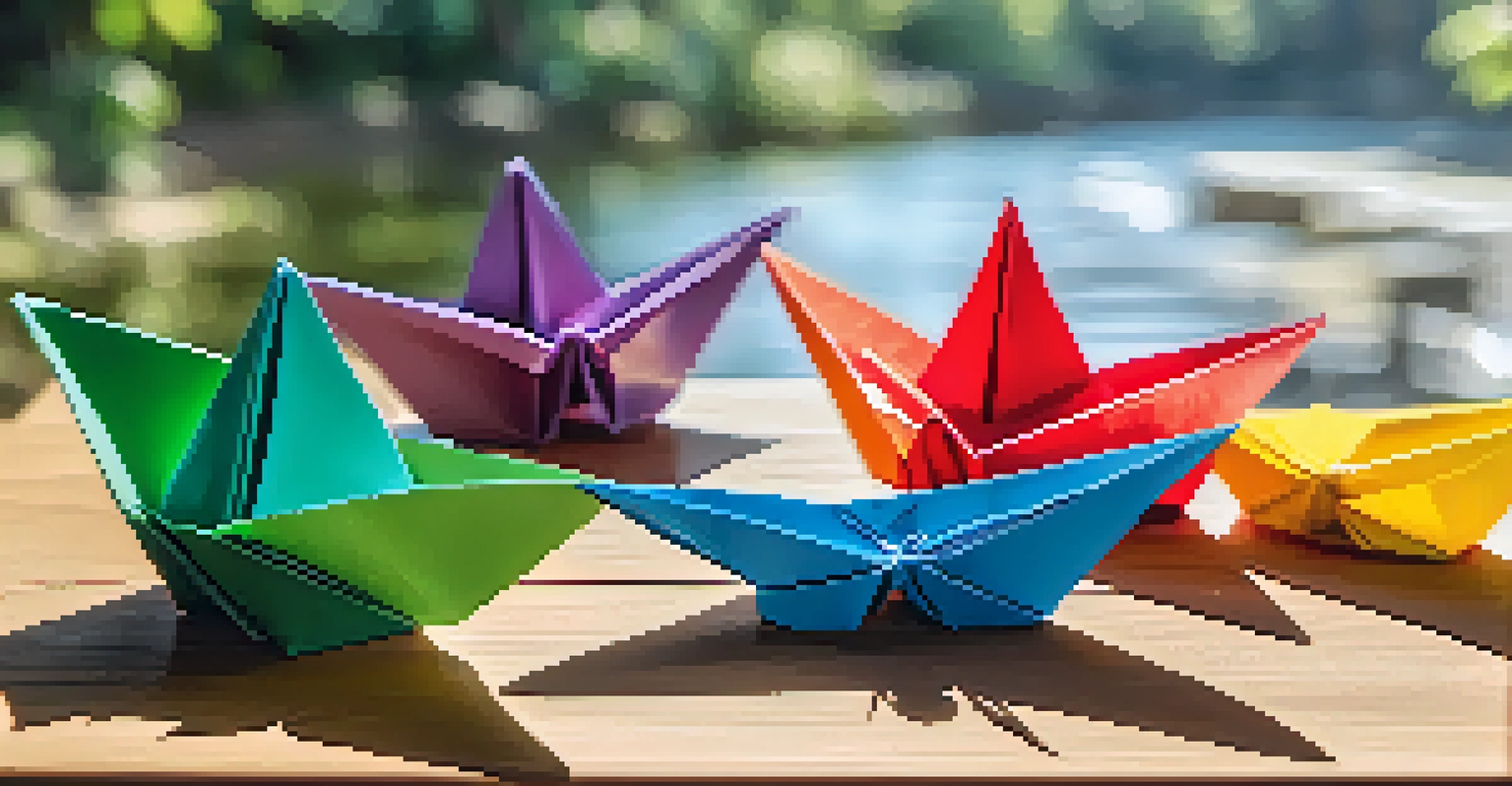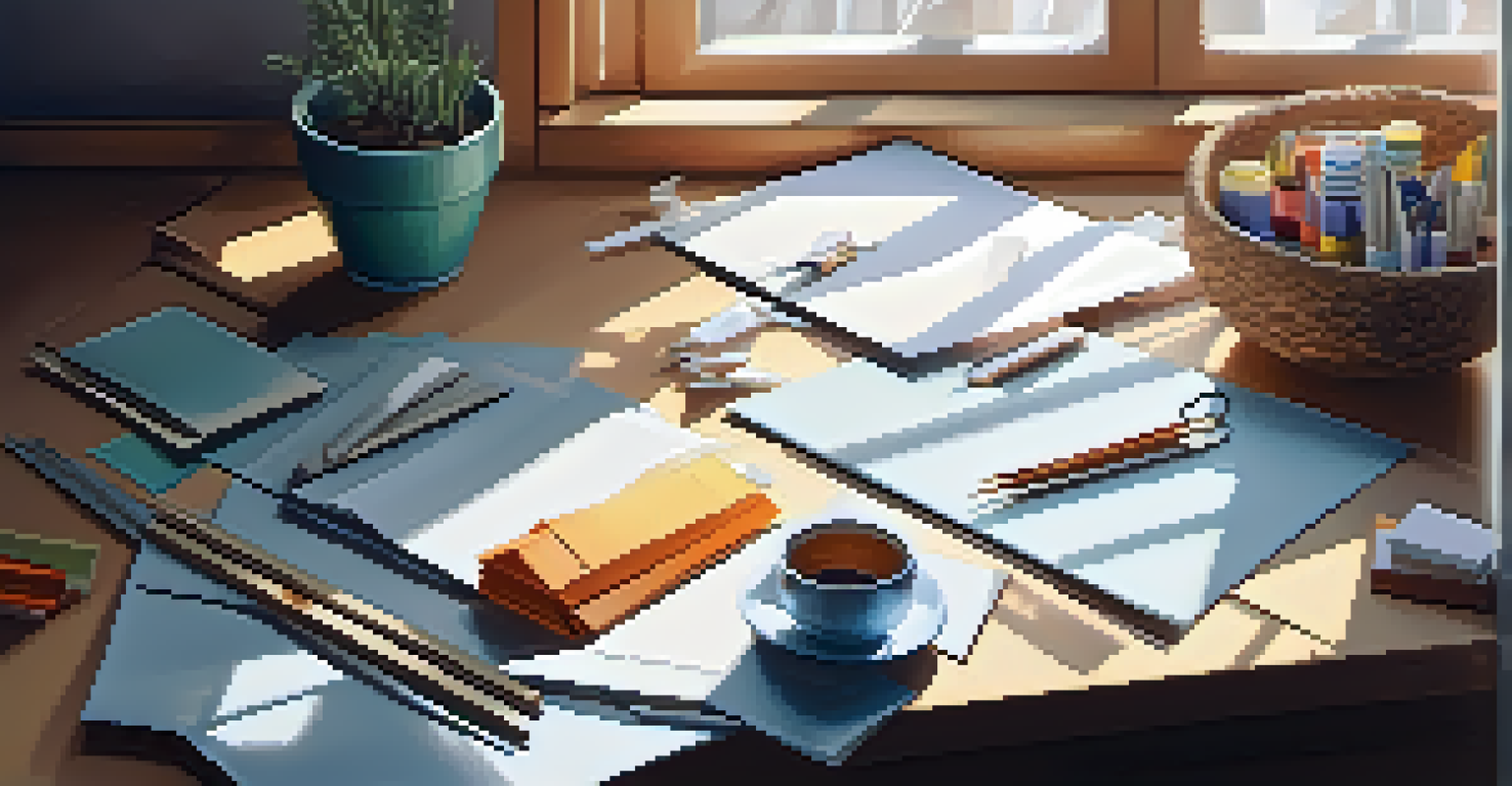Step-by-Step Guide to Creating Your First Origami Model

Understanding the Basics of Origami and Its History
Origami, the art of paper folding, has a rich history that dates back over a thousand years. Originating in Japan, it symbolizes creativity and precision, transforming simple paper into intricate designs. While many associate origami with cranes and flowers, the possibilities are endless, making it a versatile art form.
The beautiful thing about learning is that no one can take it away from you.
At its core, origami is about transforming a flat piece of paper into a three-dimensional object through a series of folds. This process not only requires creativity but also a good understanding of the basic techniques and folds that form the foundation of this art. By mastering these fundamentals, you can create anything from animals to geometric shapes.
Before diving into creating your first model, familiarize yourself with common terms like valley fold, mountain fold, and crease patterns. These concepts will be essential as you progress. Think of these basic techniques as the building blocks of your origami journey.
Gathering the Right Materials for Your Origami Project
To start your origami adventure, you need some basic materials. All you really need is a square piece of paper—origami paper is ideal due to its lightweight and vibrant colors, but regular printer paper works just fine. You might also want a pair of scissors and a ruler for precise measurements, especially for beginners.

If you're looking for a fun twist, consider using patterned paper, recycled paper, or even wrapping paper to add a personal touch to your creations. The thickness of the paper can affect how well it folds, so choose a type that suits your comfort level. Remember, the more colorful and unique your paper, the more exciting your finished model will look!
Origami Basics and Techniques
Understanding fundamental folds like valley and mountain folds is essential for creating beautiful origami models.
Once you've chosen your paper, clear a workspace where you can focus. A flat, clean surface will help you make accurate folds and avoid frustration. Organize your materials so that everything you need is within reach, setting the stage for a smooth origami experience.
Choosing Your First Origami Model to Create
As a beginner, selecting the right model is crucial to your success and enjoyment. Start with simple designs, such as a paper crane or a boat, as these models typically require fewer folds and are more forgiving of mistakes. Websites and books dedicated to origami often have beginner sections that showcase easy-to-follow instructions.
Creativity is intelligence having fun.
Look for models that come with visual diagrams or video tutorials; these resources can be incredibly helpful in guiding you through each step. Visual aids make it easier to understand the folds and transformations, reducing the chances of getting lost in the process. Plus, seeing the model take shape can be quite motivating!
Remember, the goal is to build your confidence and skills, so don’t rush. As you become more comfortable, you can gradually move on to more complex designs. Think of this journey as a ladder, where each step brings you closer to mastering the art of origami.
Learning the Basic Folds Essential for Origami
Before you start folding, it's important to know the basic folds that form the backbone of origami. The valley fold is where you fold the paper towards you, creating a 'V' shape, while the mountain fold is when you fold it away from you, forming a peak. Mastering these two folds is essential, as they are used in almost every origami model.
Another important technique is the reverse fold, which allows you to change the direction of a previous fold. This technique can be likened to a dance—sometimes you need to pivot to create the desired shape. Practice these basic folds repeatedly until you feel comfortable with them, as they will help you navigate more complex models later on.
Choosing the Right Materials
Starting with the right paper, such as origami paper or patterned paper, can enhance your folding experience and creativity.
Also, don't forget about the importance of creasing! Strong, sharp creases will ensure that your model holds its shape. Use your fingernails or a bone folder to make the folds crisp. Think of a well-creased fold as the foundation of a sturdy house—it supports everything built on top of it.
Following Step-by-Step Instructions for Your Chosen Model
Now that you've selected your model and learned the basic folds, it's time to follow the step-by-step instructions. Take your time with each step, making sure to refer back to your diagrams or videos as needed. Don’t hesitate to pause and take a moment to ensure you understand what’s being asked before moving forward.
As you follow the instructions, stay patient with yourself. It’s common to make mistakes, especially when you’re first starting out. If you find yourself stuck, take a break, and then revisit the step with fresh eyes. Remember, origami is not just about the finished product; it’s also about enjoying the process of creation.
Once you've completed your model, take a moment to appreciate your hard work. Each fold and crease represents a step in your learning journey. Whether it looks exactly like the example or not, the important part is that you tried your best and had fun!
Troubleshooting Common Origami Mistakes
Mistakes are a natural part of learning anything new, and origami is no exception. If your model isn't turning out as expected, take a deep breath and assess where things may have gone wrong. Common issues include misaligned folds and uneven creases, which can often be fixed with a little patience and adjustment.
A helpful tip is to revisit the previous steps you’ve taken. Did you fold too loosely or miss a critical crease? Understanding where the error occurred can not only fix the current model but also prevent similar mistakes in future projects. Think of it like solving a puzzle—sometimes you need to backtrack to find the right fit.
Learning Through Practice
Embracing mistakes and following step-by-step instructions will build your confidence and skills in origami.
Don’t be afraid to consult online forums or communities dedicated to origami for advice. Many seasoned folders are happy to share their experiences and troubleshooting tips. Remember, every expert was once a beginner, and sharing tips can make the learning process more enjoyable for everyone involved.
Celebrating Your Success and Exploring Advanced Models
Congratulations on completing your first origami model! Take a moment to celebrate your achievement, no matter how simple it may seem. Each creation is a testament to your newfound skills and patience, and it’s important to recognize your progress along the way.
Now that you've mastered the basics, consider exploring more advanced models. Challenge yourself with designs that require additional folds or techniques, and don’t hesitate to experiment with your own ideas. The world of origami is vast and ever-evolving, offering endless opportunities for creativity.

As you grow in confidence, you might even find joy in teaching others. Share your skills with friends or family, and inspire them to try their hand at this beautiful art form. Remember, every fold, every model, and every shared experience adds to the rich tapestry of the origami community.